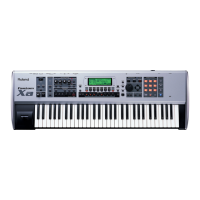170
Adding Effects
19: STEP PAN
This uses a 16-step sequence to vary the panning of the sound.
fig.MFX-19
20: SLICER
By applying successive cuts to the sound, this effect turns a
conventional sound into a sound that appears to be played as a
backing phrase. This is especially effective when applied to sustain-
type sounds.
fig.MFX-20
21: ROTARY
The Rotary effect simulates the sound of the rotary speakers often
used with the electric organs of the past. Since the movement of the
high range and low range rotors can be set independently, the
unique type of modulation characteristic of these speakers can be
simulated quite closely. This effect is most suitable for electric organ
Patches.
fig.MFX-21
Parameter
Value Explanation
Step 01–16
L64–63R Pan at each step
Rate # 0.05–10.00 Hz, note Rate at which the 16-step se-
quence will cycle
Attack # 0–127 Speed at which the pan changes
between steps
Input Sync
Sw
OFF, ON Specifies whether an input note
will cause the sequence to re-
sume from the first step of the se-
quence (ON) or not (OFF)
Input Sync
Threshold
0–127 Volume at which an input note
will be detected
Level 0–127 Output volume
Parameter
Value Explanation
Step 01–16
0–127 Level at each step
Rate # 0.05–10.00
Hz, note
Rate at which the 16-step sequence will
cycle
Attack # 0–127 Speed at which the level changes be-
tween steps
Input Sync
Sw
OFF, ON Specifies whether an input note will
cause the sequence to resume from the
first step of the sequence (ON) or not
(OFF)
Input Sync
Threshold
0–127 Volume at which an input note will be
detected
Mode LEGATO,
SLASH
Sets the manner in which the volume
changes as one step progresses to the
next.
LEGATO:
The change in volume from
one step’s level to the next remains
unaltered. If the level of a following
step is the same as the one preceding
it, there is no change in volume.
SLASH:
The level is momentarily set
to 0 before progressing to the level of
the next step. This change in volume
occurs even if the level of the follow-
ing step is the same as the preceding
step.
Shuffle # 0–127 Timing of volume changes in levels for
even-numbered steps (step 2, step 4, step
6...).
The higher the value, the later the beat
progresses.
Level 0–127 Output level
L in
R in
L out
R out
Step Pan
Step Pan
L in
R in
L out
R out
Slicer
Slicer
Parameter
Value Explanation
Speed # SLOW, FAST Simultaneously switch the rota-
tional speed of the low frequency
rotor and high frequency rotor.
SLOW:
Slows down the rota-
tion to the Slow Rate.
FAST:
Speeds up the rotation
to the Fast Rate.
Woofer Slow
Speed
0.05–10.00 Hz Slow speed (SLOW) of the low
frequency rotor
Woofer Fast
Speed
0.05–10.00 Hz Fast speed (FAST) of the low fre-
quency rotor
Woofer
Acceleration
0–15 Adjusts the time it takes the low
frequency rotor to reach the new-
ly selected speed when switch-
ing from fast to slow (or slow to
fast) speed. Lower values will re-
quire longer times.
Woofer Level 0–127 Volume of the low frequency ro-
tor
Tweeter Slow
Speed
0.05–10.00 Hz Settings of the high frequency ro-
tor
The parameters are the same
as for the low frequency rotor
Tweeter Fast
Speed
0.05–10.00 Hz
Tweeter
Acceleration
0–15
Tweeter Level 0–127
Separation 0–127 Spatial dispersion of the sound
Level # 0–127 Output Level
Rotary
L out
R out
L in
R in
Fantom-Xa_e.book 170 ページ 2004年10月22日 金曜日 午後2時3分

